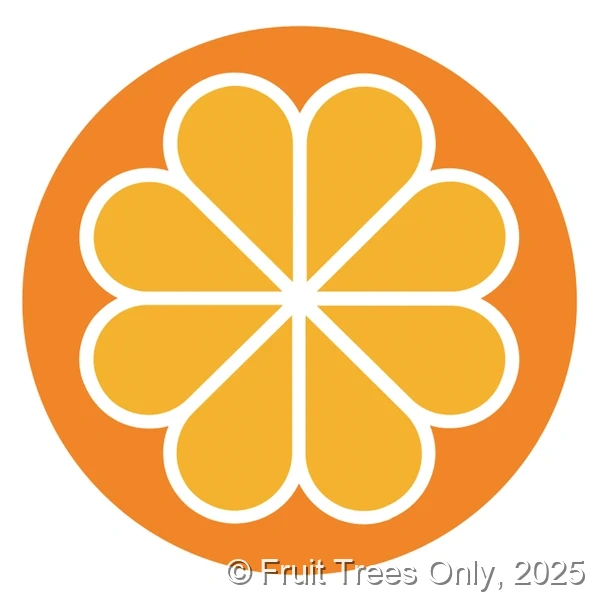Avocado Care Guides
Care instructions and guidelines for avocado plants.
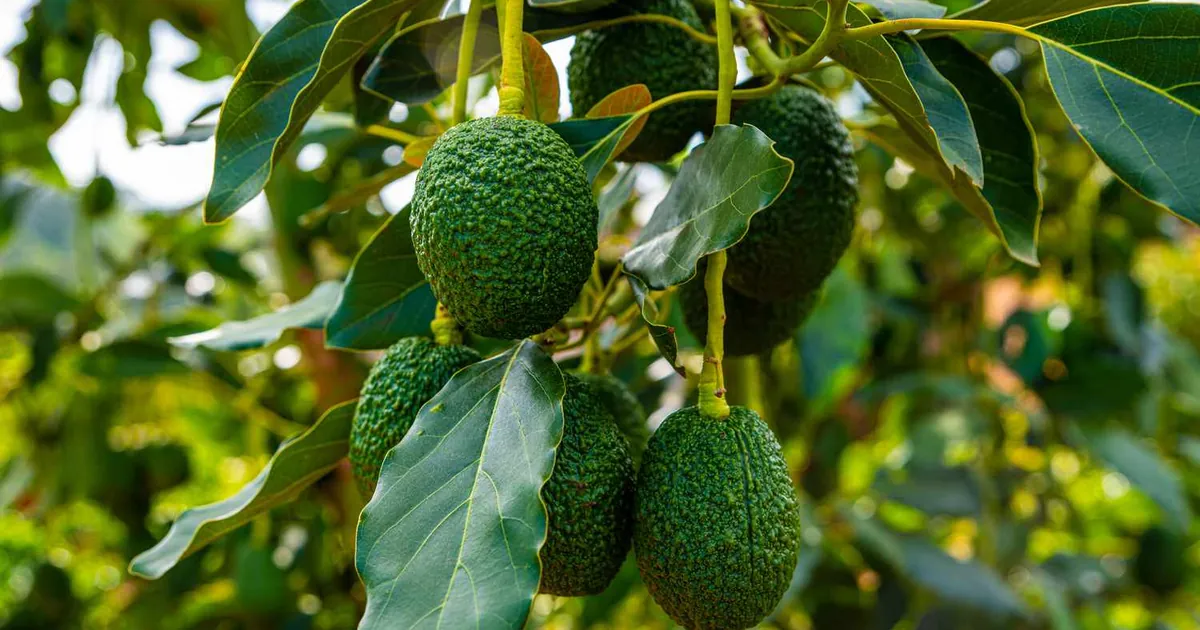
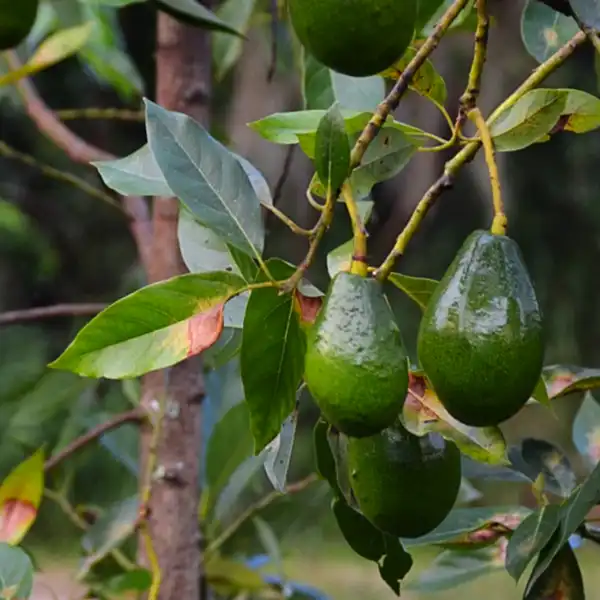
Brogdon Avocado
- Sunlight: Full sun (6–8+ hrs) and good airflow.
- Soil & Drainage: Fast‑draining soil; avoid low spots/standing water. Plant on a 2–3′ mound if drainage is marginal to reduce Phytophthora risk.
- Watering: Newly planted: every other day first week, then 1–2×/week for 1–2 months. Established: irrigate during prolonged dry periods—avoid drought stress from bloom through fruit development.
- Fertilization: Young trees: small doses every 1–2 months first year. Bearing: 3–4 feeds/yr; mixes like 6‑6‑6‑2 or 8‑3‑9‑2 with Mg; include micronutrients (Zn, Mn; Fe chelate on high‑pH soils).
- Pruning: Light structural pruning after harvest to manage height and improve light/airflow; remove dead/crossing wood.
- Pest & Disease: Florida issues include avocado lace bug, scales, mites; diseases include anthracnose/scab and Phytophthora root rot. Use copper fungicides as labeled when disease pressure is high; maintain sanitation and drainage.
- Pollination: B type; pair with A types like ‘Lula’, ‘Choquette’, or ‘Florida Hass’
- Cold Tolerance: ~22–24°F (brief dips)
- Harvest Window (FL): August–September
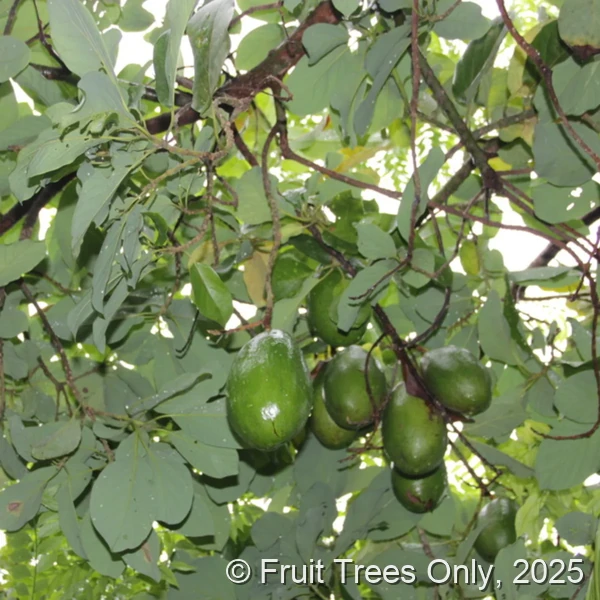
Catalina Avocado
- Sunlight: Full sun (6–8+ hrs) and good airflow.
- Soil & Drainage: Fast‑draining soil; avoid low spots/standing water. Plant on a 2–3′ mound if drainage is marginal to reduce Phytophthora risk.
- Watering: Newly planted: every other day first week, then 1–2×/week for 1–2 months. Established: irrigate during prolonged dry periods—avoid drought stress from bloom through fruit development.
- Fertilization: Young trees: small doses every 1–2 months first year. Bearing: 3–4 feeds/yr; mixes like 6‑6‑6‑2 or 8‑3‑9‑2 with Mg; include micronutrients (Zn, Mn; Fe chelate on high‑pH soils).
- Pruning: Light structural pruning after harvest to manage height and improve light/airflow; remove dead/crossing wood.
- Pest & Disease: Florida issues include avocado lace bug, scales, mites; diseases include anthracnose/scab and Phytophthora root rot. Use copper fungicides as labeled when disease pressure is high; maintain sanitation and drainage.
- Pollination: B type; pair with A types like ‘Lula’ or ‘Choquette’
- Cold Tolerance: ~26–28°F
- Harvest Window (FL): July–August
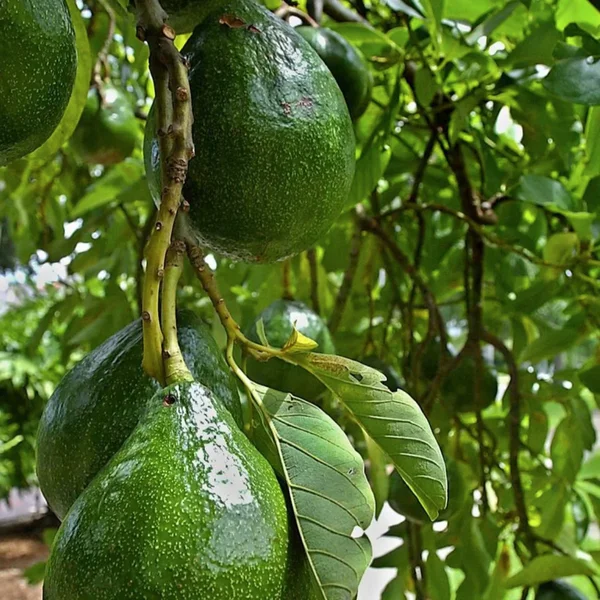
Choquette Avocado
- Sunlight: Full sun (6–8+ hrs) and good airflow.
- Soil & Drainage: Fast‑draining soil; avoid low spots/standing water. Plant on a 2–3′ mound if drainage is marginal to reduce Phytophthora risk.
- Watering: Newly planted: every other day first week, then 1–2×/week for 1–2 months. Established: irrigate during prolonged dry periods—avoid drought stress from bloom through fruit development.
- Fertilization: Young trees: small doses every 1–2 months first year. Bearing: 3–4 feeds/yr; mixes like 6‑6‑6‑2 or 8‑3‑9‑2 with Mg; include micronutrients (Zn, Mn; Fe chelate on high‑pH soils).
- Pruning: Light structural pruning after harvest to manage height and improve light/airflow; remove dead/crossing wood.
- Pest & Disease: Florida issues include avocado lace bug, scales, mites; diseases include anthracnose/scab and Phytophthora root rot. Use copper fungicides as labeled when disease pressure is high; maintain sanitation and drainage.
- Pollination: A type; pair with B types like ‘Brogdon’ or ‘Monroe’
- Cold Tolerance: ~26–28°F
- Harvest Window (FL): October–December
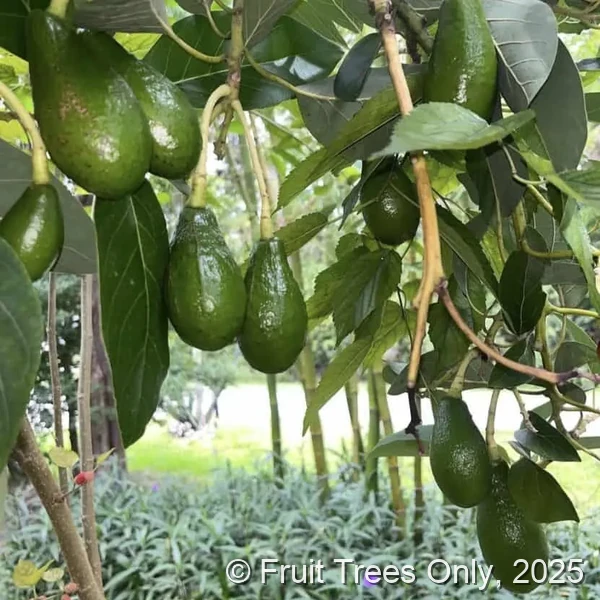
Day Avocado
- Sunlight: Full sun (6–8+ hrs) and good airflow.
- Soil & Drainage: Fast‑draining soil; avoid low spots/standing water. Plant on a 2–3′ mound if drainage is marginal to reduce Phytophthora risk.
- Watering: Newly planted: every other day first week, then 1–2×/week for 1–2 months. Established: irrigate during prolonged dry periods—avoid drought stress from bloom through fruit development.
- Fertilization: Young trees: small doses every 1–2 months first year. Bearing: 3–4 feeds/yr; mixes like 6‑6‑6‑2 or 8‑3‑9‑2 with Mg; include micronutrients (Zn, Mn; Fe chelate on high‑pH soils).
- Pruning: Light structural pruning after harvest to manage height and improve light/airflow; remove dead/crossing wood.
- Pest & Disease: Florida issues include avocado lace bug, scales, mites; diseases include anthracnose/scab and Phytophthora root rot. Use copper fungicides as labeled when disease pressure is high; maintain sanitation and drainage.
- Pollination: A type; pair with B types like ‘Brogdon’ or ‘Monroe’
- Cold Tolerance: ~24–26°F
- Harvest Window (FL): July–September
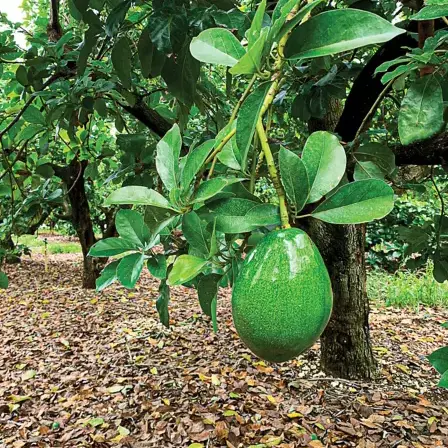
Donnie Avocado
- Sunlight: Full sun (6–8+ hrs) and good airflow.
- Soil & Drainage: Fast‑draining soil; avoid low spots/standing water. Plant on a 2–3′ mound if drainage is marginal to reduce Phytophthora risk.
- Watering: Newly planted: every other day first week, then 1–2×/week for 1–2 months. Established: irrigate during prolonged dry periods—avoid drought stress from bloom through fruit development.
- Fertilization: Young trees: small doses every 1–2 months first year. Bearing: 3–4 feeds/yr; mixes like 6‑6‑6‑2 or 8‑3‑9‑2 with Mg; include micronutrients (Zn, Mn; Fe chelate on high‑pH soils).
- Pruning: Light structural pruning after harvest to manage height and improve light/airflow; remove dead/crossing wood.
- Pest & Disease: Florida issues include avocado lace bug, scales, mites; diseases include anthracnose/scab and Phytophthora root rot. Use copper fungicides as labeled when disease pressure is high; maintain sanitation and drainage.
- Pollination: A type; pair with B types like ‘Catalina’ or ‘Brogdon’
- Cold Tolerance: ~26–28°F
- Harvest Window (FL): May–June
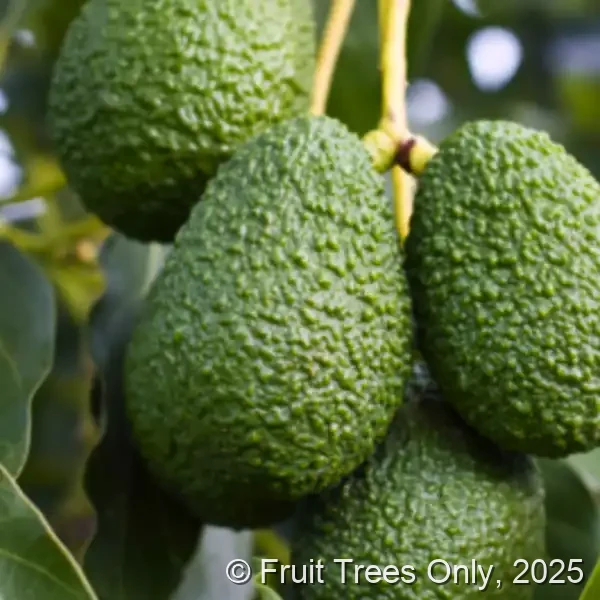
Florida Hass Avocado
- Sunlight: Full sun (6–8+ hrs) and good airflow.
- Soil & Drainage: Fast‑draining soil; avoid low spots/standing water. Plant on a 2–3′ mound if drainage is marginal to reduce Phytophthora risk.
- Watering: Newly planted: every other day first week, then 1–2×/week for 1–2 months. Established: irrigate during prolonged dry periods—avoid drought stress from bloom through fruit development.
- Fertilization: Young trees: small doses every 1–2 months first year. Bearing: 3–4 feeds/yr; mixes like 6‑6‑6‑2 or 8‑3‑9‑2 with Mg; include micronutrients (Zn, Mn; Fe chelate on high‑pH soils).
- Pruning: Light structural pruning after harvest to manage height and improve light/airflow; remove dead/crossing wood.
- Pest & Disease: Florida issues include avocado lace bug, scales, mites; diseases include anthracnose/scab and Phytophthora root rot. Use copper fungicides as labeled when disease pressure is high; maintain sanitation and drainage.
- Pollination: A type; pair with B types like ‘Monroe’ or ‘Brogdon’
- Cold Tolerance: ~24–26°F
- Harvest Window (FL): September–November
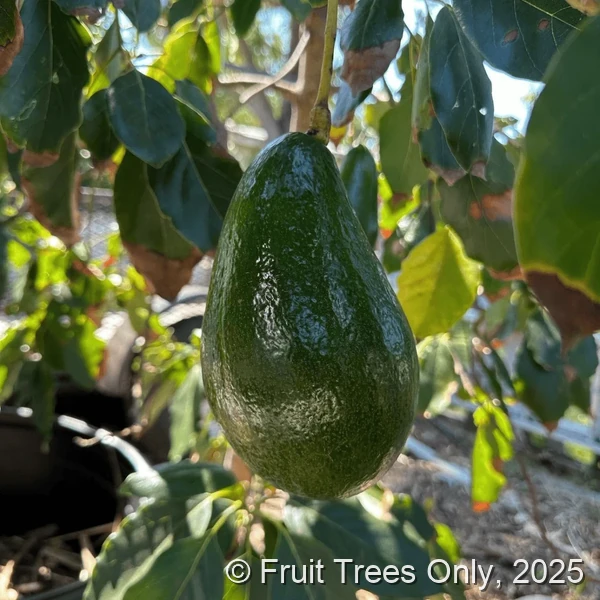
Hall Avocado
- Sunlight: Full sun (6–8+ hrs) and good airflow.
- Soil & Drainage: Fast‑draining soil; avoid low spots/standing water. Plant on a 2–3′ mound if drainage is marginal to reduce Phytophthora risk.
- Watering: Newly planted: every other day first week, then 1–2×/week for 1–2 months. Established: irrigate during prolonged dry periods—avoid drought stress from bloom through fruit development.
- Fertilization: Young trees: small doses every 1–2 months first year. Bearing: 3–4 feeds/yr; mixes like 6‑6‑6‑2 or 8‑3‑9‑2 with Mg; include micronutrients (Zn, Mn; Fe chelate on high‑pH soils).
- Pruning: Light structural pruning after harvest to manage height and improve light/airflow; remove dead/crossing wood.
- Pest & Disease: Florida issues include avocado lace bug, scales, mites; diseases include anthracnose/scab and Phytophthora root rot. Use copper fungicides as labeled when disease pressure is high; maintain sanitation and drainage.
- Pollination: B type; pair with A types like ‘Lula’ or ‘Choquette’
- Cold Tolerance: ~26°F
- Harvest Window (FL): October–November
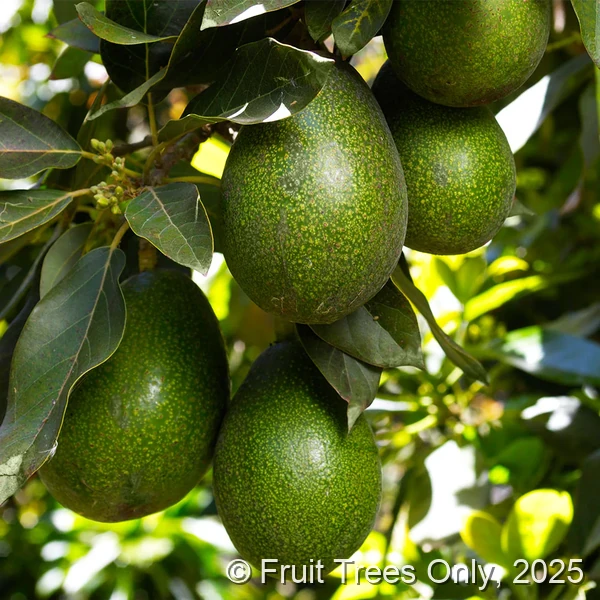
Lula Avocado
- Sunlight: Full sun (6–8+ hrs) and good airflow.
- Soil & Drainage: Fast‑draining soil; avoid low spots/standing water. Plant on a 2–3′ mound if drainage is marginal to reduce Phytophthora risk.
- Watering: Newly planted: every other day first week, then 1–2×/week for 1–2 months. Established: irrigate during prolonged dry periods—avoid drought stress from bloom through fruit development.
- Fertilization: Young trees: small doses every 1–2 months first year. Bearing: 3–4 feeds/yr; mixes like 6‑6‑6‑2 or 8‑3‑9‑2 with Mg; include micronutrients (Zn, Mn; Fe chelate on high‑pH soils).
- Pruning: Light structural pruning after harvest to manage height and improve light/airflow; remove dead/crossing wood.
- Pest & Disease: Florida issues include avocado lace bug, scales, mites; diseases include anthracnose/scab and Phytophthora root rot. Use copper fungicides as labeled when disease pressure is high; maintain sanitation and drainage.
- Pollination: A type; pair with B types like ‘Monroe’ or ‘Brogdon’
- Cold Tolerance: ~25–27°F
- Harvest Window (FL): November–January
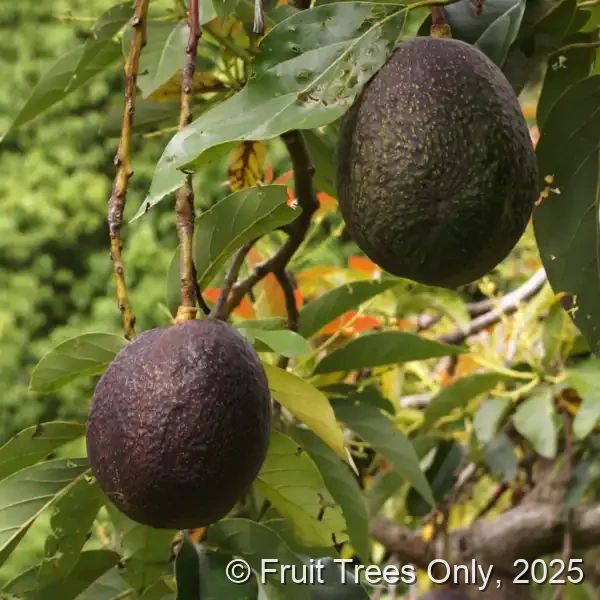
Maria Black Avocado
- Sunlight: Full sun (6–8+ hrs) and good airflow.
- Soil & Drainage: Fast‑draining soil; avoid low spots/standing water. Plant on a 2–3′ mound if drainage is marginal to reduce Phytophthora risk.
- Watering: Newly planted: every other day first week, then 1–2×/week for 1–2 months. Established: irrigate during prolonged dry periods—avoid drought stress from bloom through fruit development.
- Fertilization: Young trees: small doses every 1–2 months first year. Bearing: 3–4 feeds/yr; mixes like 6‑6‑6‑2 or 8‑3‑9‑2 with Mg; include micronutrients (Zn, Mn; Fe chelate on high‑pH soils).
- Pruning: Light structural pruning after harvest to manage height and improve light/airflow; remove dead/crossing wood.
- Pest & Disease: Florida issues include avocado lace bug, scales, mites; diseases include anthracnose/scab and Phytophthora root rot. Use copper fungicides as labeled when disease pressure is high; maintain sanitation and drainage.
- Pollination: A type; pair with B types like ‘Brogdon’ or ‘Monroe’
- Cold Tolerance: ~24–26°F
- Harvest Window (FL): October–December
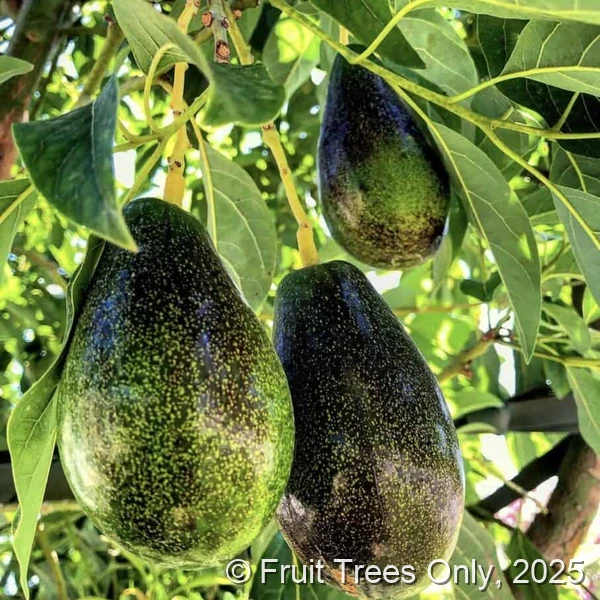
Mexicola Grande Avocado
- Sunlight: Full sun (6–8+ hrs) and good airflow.
- Soil & Drainage: Fast‑draining soil; avoid low spots/standing water. Plant on a 2–3′ mound if drainage is marginal to reduce Phytophthora risk.
- Watering: Newly planted: every other day first week, then 1–2×/week for 1–2 months. Established: irrigate during prolonged dry periods—avoid drought stress from bloom through fruit development.
- Fertilization: Young trees: small doses every 1–2 months first year. Bearing: 3–4 feeds/yr; mixes like 6‑6‑6‑2 or 8‑3‑9‑2 with Mg; include micronutrients (Zn, Mn; Fe chelate on high‑pH soils).
- Pruning: Light structural pruning after harvest to manage height and improve light/airflow; remove dead/crossing wood.
- Pest & Disease: Florida issues include avocado lace bug, scales, mites; diseases include anthracnose/scab and Phytophthora root rot. Use copper fungicides as labeled when disease pressure is high; maintain sanitation and drainage.
- Pollination: A type; pair with B types like ‘Brogdon’ or ‘Monroe’
- Cold Tolerance: ~18–20°F (brief, established trees)
- Harvest Window (FL): August–September
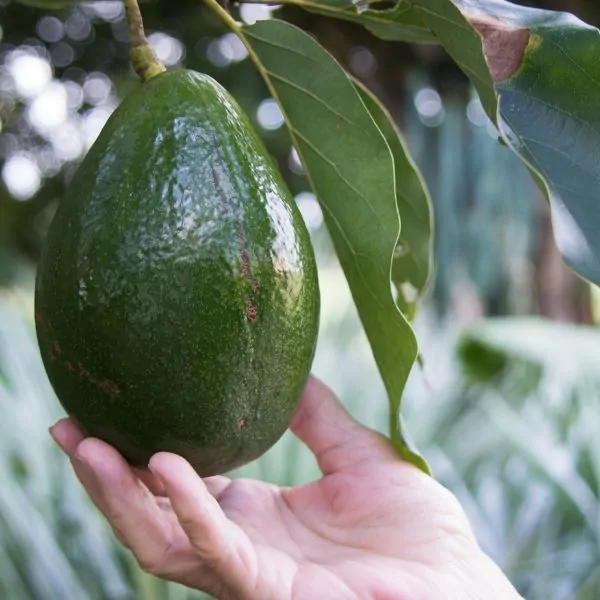
Monroe Avocado
- Sunlight: Full sun (6–8+ hrs) and good airflow.
- Soil & Drainage: Fast‑draining soil; avoid low spots/standing water. Plant on a 2–3′ mound if drainage is marginal to reduce Phytophthora risk.
- Watering: Newly planted: every other day first week, then 1–2×/week for 1–2 months. Established: irrigate during prolonged dry periods—avoid drought stress from bloom through fruit development.
- Fertilization: Young trees: small doses every 1–2 months first year. Bearing: 3–4 feeds/yr; mixes like 6‑6‑6‑2 or 8‑3‑9‑2 with Mg; include micronutrients (Zn, Mn; Fe chelate on high‑pH soils).
- Pruning: Light structural pruning after harvest to manage height and improve light/airflow; remove dead/crossing wood.
- Pest & Disease: Florida issues include avocado lace bug, scales, mites; diseases include anthracnose/scab and Phytophthora root rot. Use copper fungicides as labeled when disease pressure is high; maintain sanitation and drainage.
- Pollination: B type; pair with A types like ‘Lula’, ‘Choquette’, or ‘Florida Hass’
- Cold Tolerance: ~26°F
- Harvest Window (FL): November–January
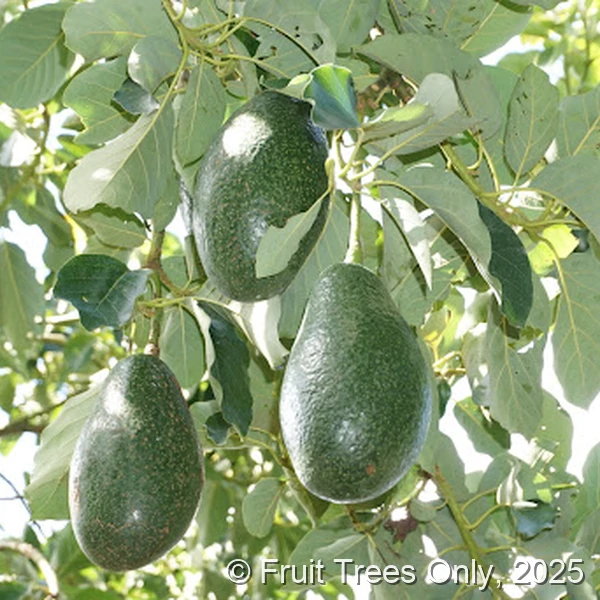
Nishikawa Avocado
- Sunlight: Full sun (6–8+ hrs) and good airflow.
- Soil & Drainage: Fast‑draining soil; avoid low spots/standing water. Plant on a 2–3′ mound if drainage is marginal to reduce Phytophthora risk.
- Watering: Newly planted: every other day first week, then 1–2×/week for 1–2 months. Established: irrigate during prolonged dry periods—avoid drought stress from bloom through fruit development.
- Fertilization: Young trees: small doses every 1–2 months first year. Bearing: 3–4 feeds/yr; mixes like 6‑6‑6‑2 or 8‑3‑9‑2 with Mg; include micronutrients (Zn, Mn; Fe chelate on high‑pH soils).
- Pruning: Light structural pruning after harvest to manage height and improve light/airflow; remove dead/crossing wood.
- Pest & Disease: Florida issues include avocado lace bug, scales, mites; diseases include anthracnose/scab and Phytophthora root rot. Use copper fungicides as labeled when disease pressure is high; maintain sanitation and drainage.
- Pollination: B type; pair with A types like ‘Lula’ or ‘Choquette’
- Cold Tolerance: ~24–26°F
- Harvest Window (FL): November–January
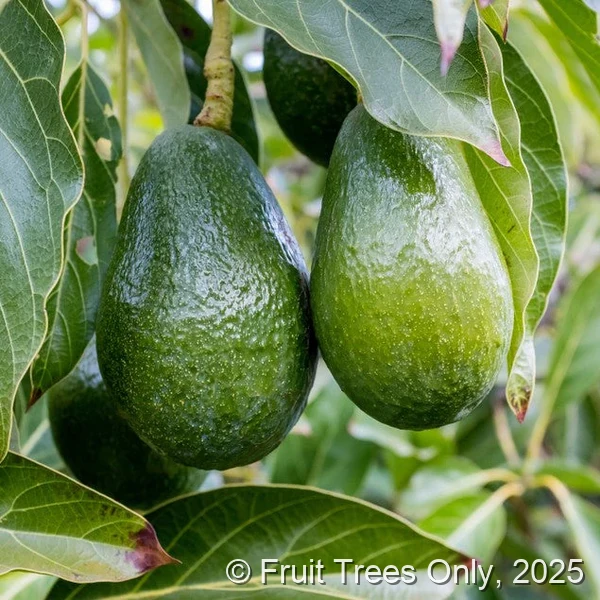
Oh La La Avocado
- Sunlight: Full sun (6–8+ hrs) and good airflow.
- Soil & Drainage: Fast‑draining soil; avoid low spots/standing water. Plant on a 2–3′ mound if drainage is marginal to reduce Phytophthora risk.
- Watering: Newly planted: every other day first week, then 1–2×/week for 1–2 months. Established: irrigate during prolonged dry periods—avoid drought stress from bloom through fruit development.
- Fertilization: Young trees: small doses every 1–2 months first year. Bearing: 3–4 feeds/yr; mixes like 6‑6‑6‑2 or 8‑3‑9‑2 with Mg; include micronutrients (Zn, Mn; Fe chelate on high‑pH soils).
- Pruning: Light structural pruning after harvest to manage height and improve light/airflow; remove dead/crossing wood.
- Pest & Disease: Florida issues include avocado lace bug, scales, mites; diseases include anthracnose/scab and Phytophthora root rot. Use copper fungicides as labeled when disease pressure is high; maintain sanitation and drainage.
- Pollination: A type; pair with B types like ‘Brogdon’ or ‘Monroe’
- Cold Tolerance: ~24–26°F
- Harvest Window (FL): September–October
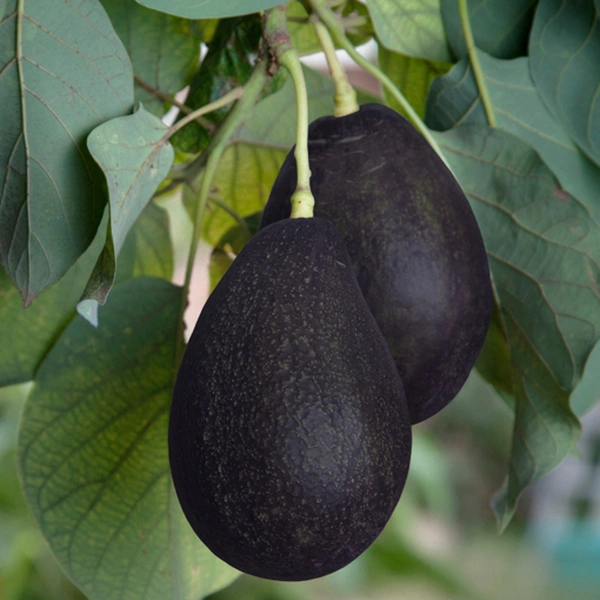
Oro Negro Avocado
- Sunlight: Full sun (6–8+ hrs) and good airflow.
- Soil & Drainage: Fast‑draining soil; avoid low spots/standing water. Plant on a 2–3′ mound if drainage is marginal to reduce Phytophthora risk.
- Watering: Newly planted: every other day first week, then 1–2×/week for 1–2 months. Established: irrigate during prolonged dry periods—avoid drought stress from bloom through fruit development.
- Fertilization: Young trees: small doses every 1–2 months first year. Bearing: 3–4 feeds/yr; mixes like 6‑6‑6‑2 or 8‑3‑9‑2 with Mg; include micronutrients (Zn, Mn; Fe chelate on high‑pH soils).
- Pruning: Light structural pruning after harvest to manage height and improve light/airflow; remove dead/crossing wood.
- Pest & Disease: Florida issues include avocado lace bug, scales, mites; diseases include anthracnose/scab and Phytophthora root rot. Use copper fungicides as labeled when disease pressure is high; maintain sanitation and drainage.
- Pollination: A type; pair with B types like ‘Monroe’ or ‘Brogdon’
- Cold Tolerance: ~24–26°F
- Harvest Window (FL): November–January
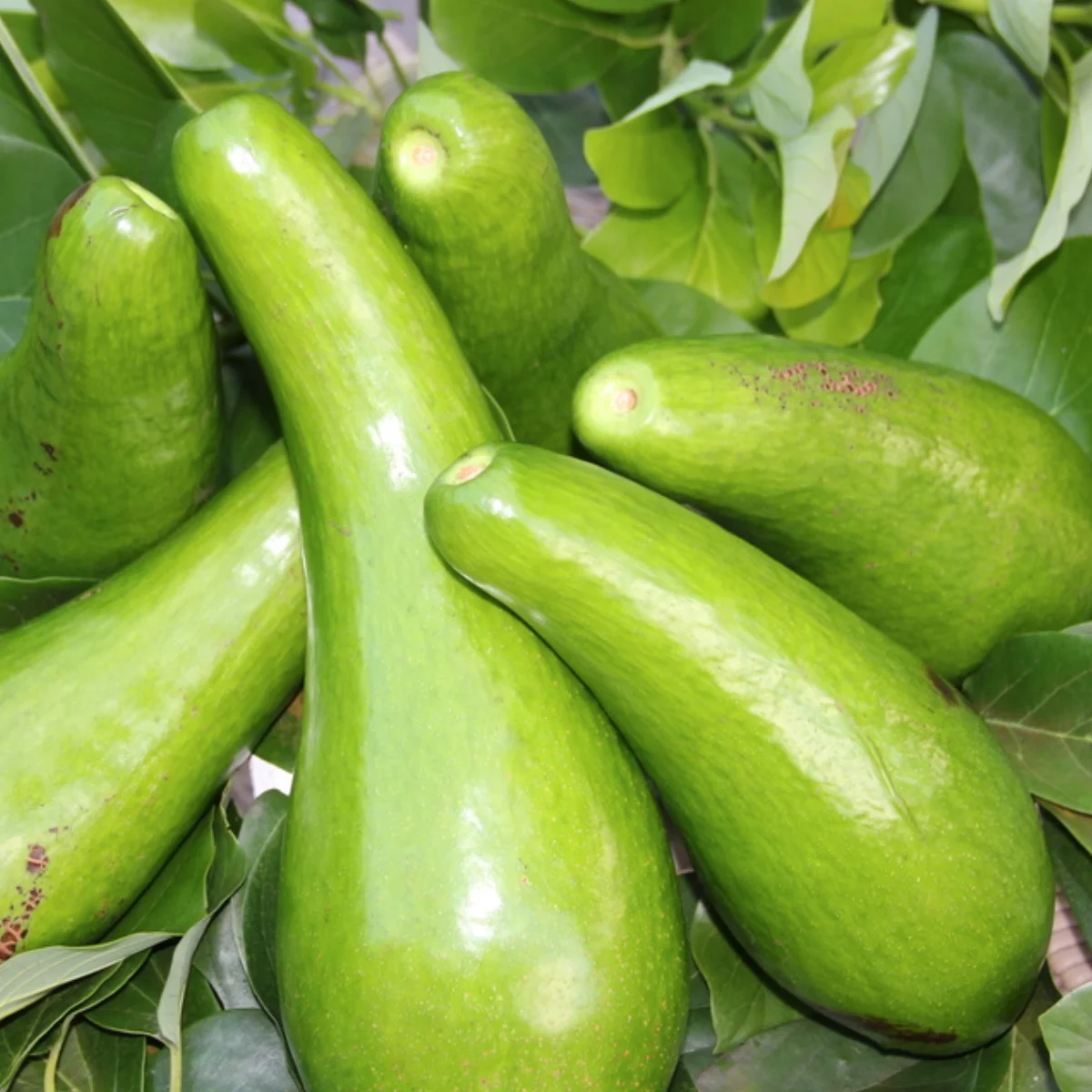
Russell Avocado
- Sunlight: Full sun (6–8+ hrs) and good airflow.
- Soil & Drainage: Fast‑draining soil; avoid low spots/standing water. Plant on a 2–3′ mound if drainage is marginal to reduce Phytophthora risk.
- Watering: Newly planted: every other day first week, then 1–2×/week for 1–2 months. Established: irrigate during prolonged dry periods—avoid drought stress from bloom through fruit development.
- Fertilization: Young trees: small doses every 1–2 months first year. Bearing: 3–4 feeds/yr; mixes like 6‑6‑6‑2 or 8‑3‑9‑2 with Mg; include micronutrients (Zn, Mn; Fe chelate on high‑pH soils).
- Pruning: Light structural pruning after harvest to manage height and improve light/airflow; remove dead/crossing wood.
- Pest & Disease: Florida issues include avocado lace bug, scales, mites; diseases include anthracnose/scab and Phytophthora root rot. Use copper fungicides as labeled when disease pressure is high; maintain sanitation and drainage.
- Pollination: B type; pair with A types like ‘Lula’ or ‘Choquette’
- Cold Tolerance: ~26°F
- Harvest Window (FL): July–August
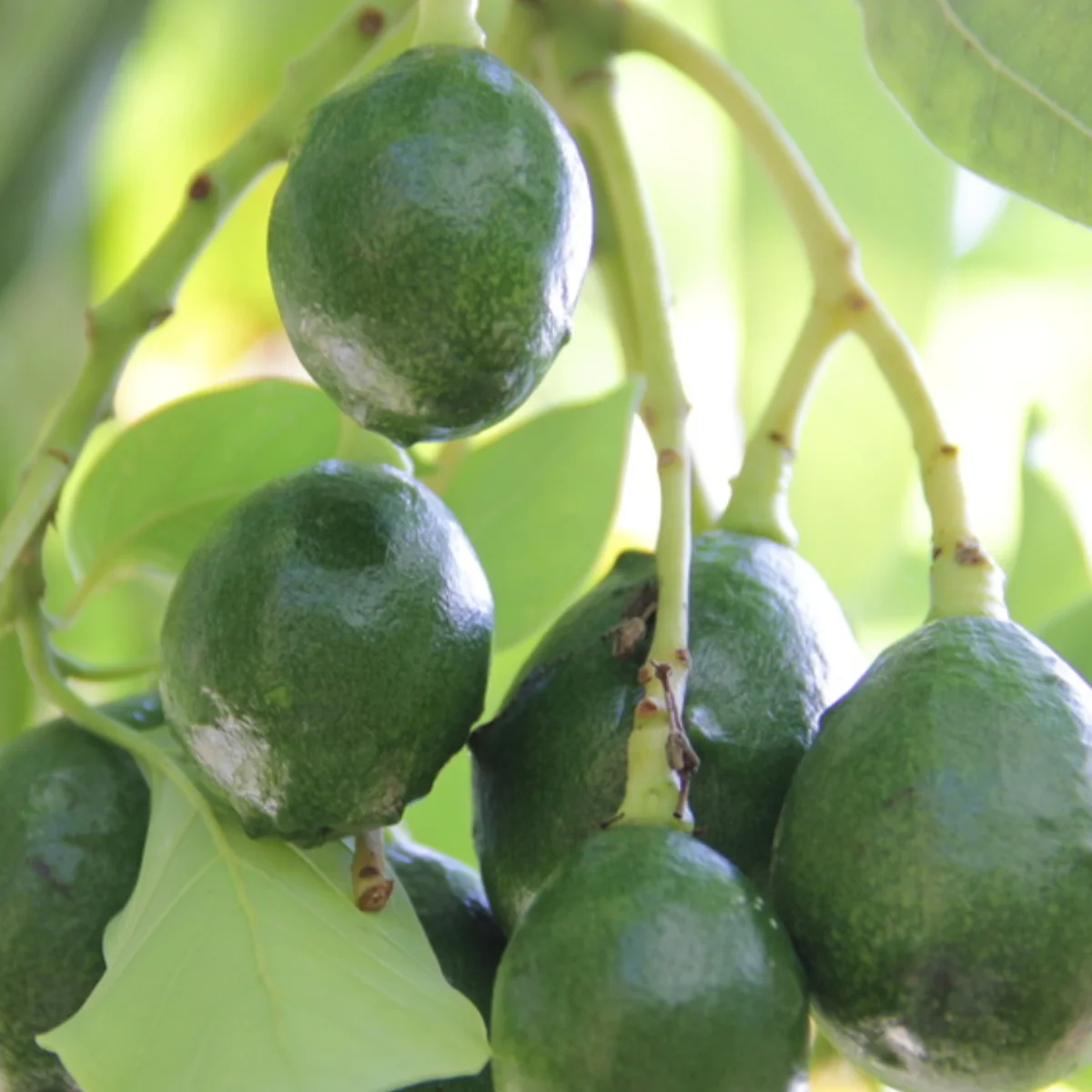
Simmonds Avocado
- Sunlight: Full sun (6–8+ hrs) and good airflow.
- Soil & Drainage: Fast‑draining soil; avoid low spots/standing water. Plant on a 2–3′ mound if drainage is marginal to reduce Phytophthora risk.
- Watering: Newly planted: every other day first week, then 1–2×/week for 1–2 months. Established: irrigate during prolonged dry periods—avoid drought stress from bloom through fruit development.
- Fertilization: Young trees: small doses every 1–2 months first year. Bearing: 3–4 feeds/yr; mixes like 6‑6‑6‑2 or 8‑3‑9‑2 with Mg; include micronutrients (Zn, Mn; Fe chelate on high‑pH soils).
- Pruning: Light structural pruning after harvest to manage height and improve light/airflow; remove dead/crossing wood.
- Pest & Disease: Florida issues include avocado lace bug, scales, mites; diseases include anthracnose/scab and Phytophthora root rot. Use copper fungicides as labeled when disease pressure is high; maintain sanitation and drainage.
- Pollination: A type; pair with B types like ‘Catalina’ or ‘Brogdon’
- Cold Tolerance: ~26–28°F
- Harvest Window (FL): June–August
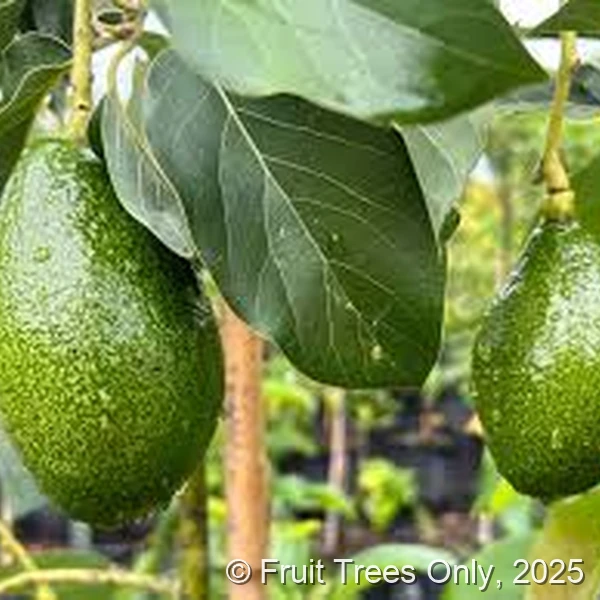
Utuado Avocado
- Sunlight: Full sun (6–8+ hrs) and good airflow.
- Soil & Drainage: Fast‑draining soil; avoid low spots/standing water. Plant on a 2–3′ mound if drainage is marginal to reduce Phytophthora risk.
- Watering: Newly planted: every other day first week, then 1–2×/week for 1–2 months. Established: irrigate during prolonged dry periods—avoid drought stress from bloom through fruit development.
- Fertilization: Young trees: small doses every 1–2 months first year. Bearing: 3–4 feeds/yr; mixes like 6‑6‑6‑2 or 8‑3‑9‑2 with Mg; include micronutrients (Zn, Mn; Fe chelate on high‑pH soils).
- Pruning: Light structural pruning after harvest to manage height and improve light/airflow; remove dead/crossing wood.
- Pest & Disease: Florida issues include avocado lace bug, scales, mites; diseases include anthracnose/scab and Phytophthora root rot. Use copper fungicides as labeled when disease pressure is high; maintain sanitation and drainage.
- Pollination: B type; pair with A types like ‘Lula’ or ‘Choquette’
- Cold Tolerance: ~26–28°F
- Harvest Window (FL): August–September

Wurtz (Little Cado) Avocado
- Sunlight: Full sun (6–8+ hrs) and good airflow.
- Soil & Drainage: Fast‑draining soil; avoid low spots/standing water. Plant on a 2–3′ mound if drainage is marginal to reduce Phytophthora risk.
- Watering: Newly planted: every other day first week, then 1–2×/week for 1–2 months. Established: irrigate during prolonged dry periods—avoid drought stress from bloom through fruit development.
- Fertilization: Young trees: small doses every 1–2 months first year. Bearing: 3–4 feeds/yr; mixes like 6‑6‑6‑2 or 8‑3‑9‑2 with Mg; include micronutrients (Zn, Mn; Fe chelate on high‑pH soils).
- Pruning: Light structural pruning after harvest to manage height and improve light/airflow; remove dead/crossing wood.
- Pest & Disease: Florida issues include avocado lace bug, scales, mites; diseases include anthracnose/scab and Phytophthora root rot. Use copper fungicides as labeled when disease pressure is high; maintain sanitation and drainage.
- Pollination: A type; pair with B types like ‘Brogdon’ or ‘Monroe’
- Cold Tolerance: ~24–26°F
- Harvest Window (FL): June–September
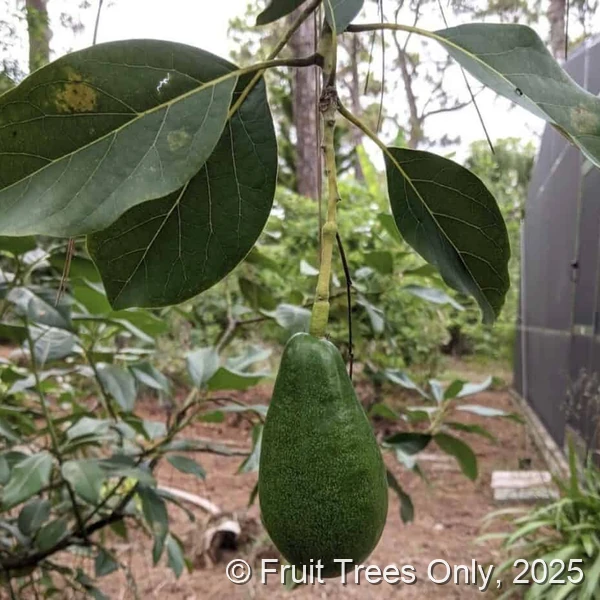
Winter Mexican Avocado
- Sunlight: Full sun (6–8+ hrs) and good airflow.
- Soil & Drainage: Fast‑draining soil; avoid low spots/standing water. Plant on a 2–3′ mound if drainage is marginal to reduce Phytophthora risk.
- Watering: Newly planted: every other day first week, then 1–2×/week for 1–2 months. Established: irrigate during prolonged dry periods—avoid drought stress from bloom through fruit development.
- Fertilization: Young trees: small doses every 1–2 months first year. Bearing: 3–4 feeds/yr; mixes like 6‑6‑6‑2 or 8‑3‑9‑2 with Mg; include micronutrients (Zn, Mn; Fe chelate on high‑pH soils).
- Pruning: Light structural pruning after harvest to manage height and improve light/airflow; remove dead/crossing wood.
- Pest & Disease: Florida issues include avocado lace bug, scales, mites; diseases include anthracnose/scab and Phytophthora root rot. Use copper fungicides as labeled when disease pressure is high; maintain sanitation and drainage.
- Pollination: B type; pair with A types like ‘Lula’ or ‘Choquette’
- Cold Tolerance: ~22–24°F
- Harvest Window (FL): November–January
